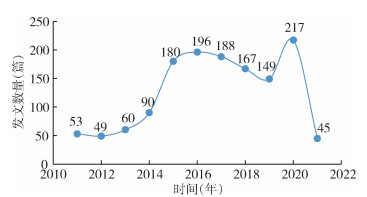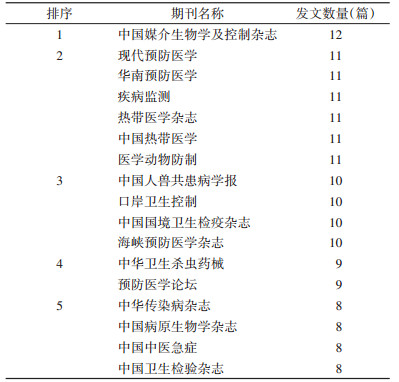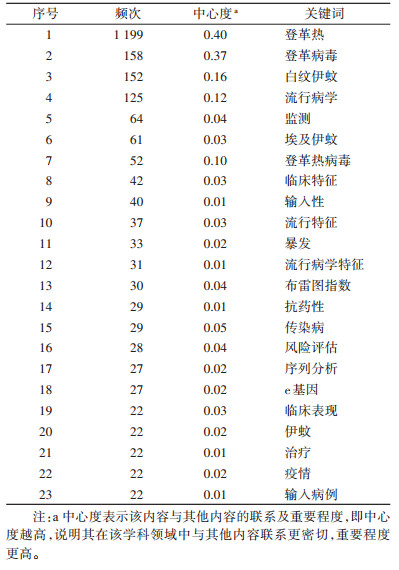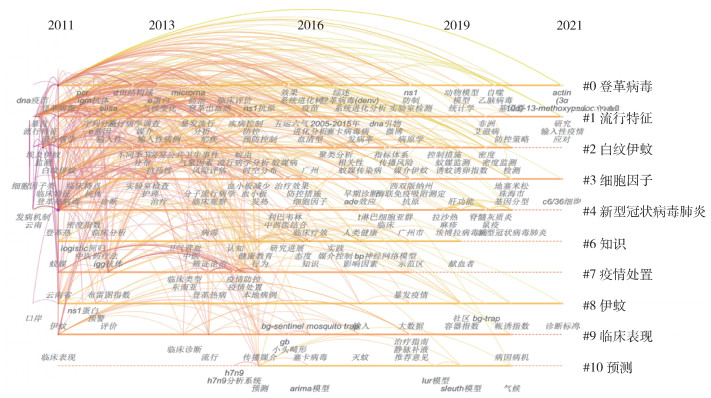扩展功能
文章信息
- 王彦丁, 李志强, 吴迪, 贡鑫然, 杨美涛, 张文义, 王勇
- WANG Yan-ding, LI Zhi-qiang, WU Di, GONG Xin-ran, YANG Mei-tao, ZHNAG Wen-yi, WANG Yong
- 基于中国知网的2011-2021年中国登革热研究进展与热点分析
- An analysis of research advances and hot spots of dengue fever in China, 2011-2021 based on CNKI
- 中国媒介生物学及控制杂志, 2022, 33(1): 114-119
- Chin J Vector Biol & Control, 2022, 33(1): 114-119
- 10.11853/j.issn.1003.8280.2022.01.021
-
文章历史
- 收稿日期: 2021-06-22
2 中国人民解放军疾病预防控制中心, 北京 100071
2 Center for Disease Control and Prevention of Chinese People's Liberation Army, Beijing 100071, China
登革热被视为全球传播最迅速的一种高风险的蚊媒病毒性传染病[1],是全球各国传染病防控工作所面临的一个亟待解决的难题。全球大约有一半人口受到该病的威胁,登革热历史上曾引起多次大规模暴发流行,主要分布于热带、亚热带的非洲、美洲、东南亚、西太平洋和欧洲[2-3]。一项登革热的系统评价显示[4],2010年之后多数与暴发有关的登革热病例主要集中在西太平洋区域,如新加坡、中国、马来西亚。我国地处亚洲中心位置,国土区域包含热带、亚热带等,尤其在我国的南方及其沿海等地区[5-7],如广东、云南、福建、浙江等地近年来登革热病例时有报道。2015-2019年,我国大陆地区共报告22 599例登革热病例(分布在28个省份),登革热的分布范围呈现不断扩散的趋势[8]。登革热在我国被划分为乙类传染病,作为一种病毒性传染病,感染的患者常具有多种临床症状,如体温升高(40 ℃)、头痛、肌肉关节痛、全身乏力、恶心呕吐等,部分患者伴有皮疹、淋巴结肿大等症状,严重者可发展为登革出血热、脓毒血症、登革休克综合征甚至危及生命[9-10]。我国也积极制定多种防控策略不断加强对登革热的监测控制,研究人员的研究重点主要集中在流行病学特征以及媒介生物防控综合治理方面,但是近年来登革热不断扩散的趋势对我国登革热防控带来严重挑战。
文献计量分析作为一种探索研究主题内容热点与未来发展趋势的方法,可以快速分析目前研究领域的热点和存在的不足,目前这种方法已用于不同的研究领域[11-12]。因此本文通过文献计量的方法,分析我国2011-2021年登革热研究热点趋势,以了解我国的登革热研究现状,为未来有效防治登革热提供可靠的文献证据与参考。
1 材料与方法 1.1 数据来源以“登革热”、“登革热病毒”为主题词,对2011年1月1日-2021年4月10日期间被中国知网(CNKI)数据库收录的登革热文献进行检索。共检索获得文献1 738篇,排除会议、报纸等不相关以及重复的文献,以“refworks”格式导出,最终纳入1 394篇文献进行分析。
1.2 研究方法对纳入的1 394篇文献数据用Excel 2019与CiteSpace 5.6.R5软件进行分析。CiteSpace软件是由美国德雷塞尔大学计算与信息学院的陈超美教授团队所研发[13],可通过设置不同的参数分析文献领域的特征和研究热点等。本文基于此软件,对登革热文献的发文时间、作者、期刊、关键词、突现词(是计量分析中一种可直观展示领域内研究热点的方式,包含了对关键词、时间、强度、起止时间的说明)等进行可视化与知识图谱分析。
2 结果 2.1 发文时间分布从中国知网收录的1 394篇文献时间分布来看,国内关于登革热的研究总体呈现上升趋势;其中2011-2013年为缓慢增长阶段,2014-2016年为快速增长阶段;2017-2021年呈现下滑波动变化,在2020年明显增加(217篇)。见图 1。

|
| 注:研究纳入的文献时点截止到2021年4月10日。 图 1 2011-2021年中国登革热发文数量分析 Figure 1 Analysis of number of publications on dengue fever in China, 2011-2021 |
| |
2011-2021年中国知网收录的登革热文献对作者分析显示(表 1),此领域内活跃的学者景钦隆、杨智聪、刘起勇列前3位,发文数量均 > 20篇,前5位作者累计发文数量为203篇,占全部发表文献的15.69%。2011-2021年中国知网收录的登革热相关文献,国内共有11本杂志刊登在10篇以上,排在第1位的为中国媒介生物学及控制杂志刊出12篇;现代预防医学、华南预防医学、疾病监测等6本期刊刊登相关文献均为11篇;排在第3位的中国人兽共患病学报、中国国境卫生检疫杂志等4本期刊,发文量均为10篇,其他期刊发文数量见表 2。

|

|
第一作者所在机构主要集中于各级疾病预防控制中心(CDC)、大学、医院及研究院等机构,其中排在前5位的分别为广州市CDC、广州市第八人民医院、云南省寄生虫病防治所、南方医科大学和广东省CDC,这5家机构发文数量均在45篇以上,占全部发文机构数量的20.01%,前10家机构发文共442篇,占全部发表文章的31.71%。前10位登革热研究机构分析见表 3。

|
本次研究选取频次 > 20的关键词进行分析,发现登革热领域内的研究主要集中在流行病学、监测、媒介伊蚊、临床特征及治疗等方面。其中排在第1位的关键词是登革热,频次高达1 199次;第2位是登革病毒,频次为158次;第3~5位的分别为白纹伊蚊(Aedes albopictus)、流行病学和监测,频次分别为152、125和64次。埃及伊蚊(Ae. aegypti)和登革热病毒频次在50次以上,分别排在第6、7位。在CiteSpace软件分析中,关键词中心度 > 0.10默认为关键节点,此次研究中登革热、登革病毒、白纹伊蚊、流行病学等是关键节点(中心度均 > 0.10),其他见表 4。

|
2011-2021年登革热的热点研究逐渐从输入病例和流行病学调查发展到登革热的护理、进化分析和抗药性等,展示了相关关键词随时间衰落或兴起的情况。2012-2015年常见的突现词为基孔肯雅热;2019-2021年突现词为埃博拉病毒病;2020-2021年的突现词转为新型冠状病毒肺炎。本研究中强度靠前的突现词主要包含新型冠状病毒肺炎、基孔肯雅热、输入性、流行病学等。见图 2。

|
| 注:a代表每个突现词的强度,表示其所对应的突现词的热门程度与数值大小呈正比,即数值越大,在起止时间段内更热门。红色部分为此突现词经过算法生成的热门时间节点,代表从开始至结束的时间。 图 2 2011-2021年中国知网收录的国内登革热研究的突现词 Figure 2 Burst terms of dengue fever research in China included in China National Knowledge Infrastructure, 2011-2021 |
| |
本次分析的1 394篇文献中,时间线分析共获得10个标签,包含了2011-2021年间的登革病毒、流行特征、媒介分析、疫情处置、临床表现及传染病预测分析等(图 3),标签的主要内容分析见表 5。

|
| 注:#0~#10代表标签。 图 3 2011-2021年中国知网收录的登革热国内研究时间线分析 Figure 3 Timeline analysis of dengue fever research in China included in China National Knowledge Infrastructure, 2011-2021 |
| |

|
近年来,随着全球化趋势的不断发展,在社会、经济、环境多重因素的影响下(国际贸易、旅行、城市化、气候、公共卫生设施、人口密度、卫生知识等)[14-16],登革热仍处于发展蔓延的状态,其发病率和死亡率尚未得到更好的控制。随着我国登革热的流行区域逐渐扩大,人群面临的传染风险加剧,并可能随着贸易和旅游向国际间传播[8]。2014年我国南方地区暴发登革热,出现历史新高,广州市等地疫情较为严重[17-18],登革热发文数量在2014年后呈现快速增长趋势。广州、深圳等地是我国的重要经济和交通枢纽,人口活动频繁,并且其地处亚热带季风气候区,天气环境适合登革热传播媒介的生长[19-20],因此研究所在机构多集中在南方及沿海地区。
本研究利用文献计量的方法,对2011年1月1日-2021年4月10日中国知网收录的登革热研究文献进行多维度的分析,从时间、热点上分析了研究主题的变化,较清晰地展现了国内有关登革热研究的发展与变化。由于国内的研究水平和方向侧重的差异,2011-2021年间发表的文献主要集中于病原学、流行病学、虫媒等方面,而对疫情的整体防控与风险评估研究较少。近10年来,登革热的研究热点由对登革热的流行病学特征分析到临床治疗与社会影响分析逐渐变化[20-23],同时由于受到新发传染病暴发的影响,突现词转为与当年疫情相关的基孔肯雅热、埃博拉病毒病与新型冠状病毒肺炎,具有一定的时效特性。
本次分析中的热点尚未包含关于抗体依赖性增强(antibody dependent enhancement,ADE)及其相关机制的描述,但近年来ADE相关研究受到国内外学者的广泛关注。关于登革病毒引起的免疫反应的研究表明,治疗登革热的减毒活疫苗主要诱导针对登革病毒前膜(prM)和融合环表位(FLE)的抗体(Abs),这些抗体通常在登革病毒血清型之间发生交叉反应,虽然病毒产生的抗体有助于持久的同型免疫,但也可能产生异型登革病毒感染的风险[24-25],促进病毒复制和加重疾病严重程度,即导致ADE的发生。因此,了解抗体介导中和的细胞、生化和分子基础与ADE对于开发安全的登革病毒疫苗至关重要。迄今为止不同的研究中,针对结构蛋白的抗体,如包膜和prM,在登革热的治疗中发挥了重要作用,因为其有利于阻止病毒进入并抑制病毒附着到宿主细胞。然而,由于ADE导致的健康风险,针对所有4种登革病毒血清型的安全性和疗效问题仍然是一个巨大的挑战[26]。
近几年来登革热早期诊断和快速诊断在登革热防控中发挥了重大作用,尤其是在登革热核酸诊断及其在分子分型溯源分析方面发展迅速。目前常采用的方法主要包括提取病毒核酸、荧光反转录聚合酶链式反应(RT-PCR)病毒分型检测、血清学检测、全基因序列测定及系统进化分析等[27-29]。随着高通量测序技术(NGS)的发展,可应用其对宿主(人类或蚊虫)内的病毒种群和宿主(人类和蚊虫)之间的传播进行全基因组的分析[30],多重荧光体系的应用也在登革热诊断与鉴别诊断上发挥了重要作用。此外,对登革热感染病例开展流行病学调查,分析登革病毒分子特征,可确定病毒的基因型及感染来源。
此外,非结构蛋白1(NS1)诊断发展及其相关的快速诊断技术的研发与应用亦是未来不能够忽视的研究热点。NS1是被感染宿主细胞持续分泌的唯一蛋白质,在登革热感染期间可能导致血管渗漏、凝血病和血小板减少。NS1可在患者血清中分泌,多年来一直被用作登革热感染的早期诊断标志物,被认为是登革热中一种独特的“病毒毒素”[31-33]。然而,NS1在登革热诱发的血管渗漏中的作用直到近年来才受到学者们的逐渐重视,在未来,预计会有更多科学家基于登革热发病的分子机制,探索以NS1蛋白等作为抗登革热感染的药物和疫苗开发靶点的可能性,从而开发针对不同结构或非结构蛋白的更有效的抗病毒方法。
但此次研究仍存在一定的局限性,主要包含以下内容:(1)此次收集的文献仅来源于中国知网数据库。为了更好地理解登革热相关的研究,未来需要更好、更大的数据集。(2)在本研究中,我们仅纳入了2011-2021年基于中国知网的研究,可能会遗漏一些关于登革热的出版物及相关的记录。希望未来进一步的研究能扩大时间尺度的分析,并结合国外数据库探索更多关于该领域内的记录和出版物。但本文通过可视化和文献计量学分析来探索登革热的进展与热点,进一步分析登革热疫情的特点和未来研究趋势,有助于疾病监控与预警研究的深入,为推动登革热防控的科学性、有效性和成果效益提供参考。
利益冲突 无
| [1] |
Guzman MG, Harris E. Dengue[J]. Lancet, 2015, 385(9966): 453-465. DOI:10.1016/S0140-6736(14)60572-9 |
| [2] |
Arima Y, Chiew M, Matsui T. Epidemiological update on the dengue situation in the Western Pacific Region, 2012[J]. Western Pac Surveill Response J, 2015, 6(2): 82-89. DOI:10.5365/WPSAR.2014.5.4.002 |
| [3] |
Tambo E, Chen JH, Zhou XN, et al. Outwitting dengue threat and epidemics resurgence in Asia-Pacific countries: strengthening integrated dengue surveillance, monitoring and response systems[J]. Infect Dis Poverty, 2016, 5(1): 56. DOI:10.1186/s40249-016-0148-3 |
| [4] |
Guo CC, Zhou ZX, Wen ZH, et al. Global epidemiology of dengue outbreaks in 1990-2015: A systematic review and meta-analysis[J]. Front Cell Infect Microbiol, 2017, 7: 317. DOI:10.3389/fcimb.2017.00317 |
| [5] |
赵峥, 李昱, 牟笛, 等. 2016-2018年中国重点省份境外输入性登革热病例的时空分析[J]. 中华流行病学杂志, 2020, 41(11): 1808-1812. Zhao Z, Li Y, Mou D, et al. Spatial-temporal analysis on imported dengue fever in six provinces of China, 2016-2018[J]. Chin J Epidemiol, 2020, 41(11): 1808-1812. DOI:10.3760/cma.j.cn112338-20191231-00923 |
| [6] |
岳玉娟, 吴海霞, 李贵昌, 等. 2005-2013年中国大陆登革热病例空间分析[J]. 现代预防医学, 2016, 43(8): 1345-1348, 1354. Yue YJ, Wu HX, Li GC, et al. Spatial analysis of dengue fever in mainland China between 2005 and 2013[J]. Mod Prev Med, 2016, 43(8): 1345-1348, 1354. |
| [7] |
周克梅, 杨明东, 兰学梅, 等. 云南省129个县(市、区)主城区登革热媒介伊蚊分布调查[J]. 中国媒介生物学及控制杂志, 2021, 32(2): 150-157. Zhou KM, Yang MD, Lan XM, et al. An investigation of the distribution of dengue vector Aedes in the main urban areas of 129 counties (cities, districts) of Yunnan province, China[J]. Chin J Vector Biol Control, 2021, 32(2): 150-157. DOI:10.11853/j.issn.1003.8280.2021.02.006 |
| [8] |
刘起勇. 我国登革热流行新趋势、防控挑战及策略分析[J]. 中国媒介生物学及控制杂志, 2020, 31(1): 1-6. Liu QY. Dengue fever in China: new epidemical trend, challenges and strategies for prevention and control[J]. Chin J Vector Biol Control, 2020, 31(1): 1-6. DOI:10.11853/j.issn.1003.8280.2020.01.001 |
| [9] |
Cao JQ, Deng H, Ye L, et al. Epidemiological and clinical characteristics of dengue virus outbreaks in two regions of China, 2014-2015[J]. PLoS One, 2019, 14(3): e0213353. DOI:10.1371/journal.pone.0213353 |
| [10] |
Gubler DJ. Dengue and dengue hemorrhagic fever[J]. Clin Microbiol Rev, 1998, 11(3): 480-496. DOI:10.1128/CMR.11.3.480 |
| [11] |
Zhong DL, Luo SX, Zheng LL, et al. Epilepsy occurrence and circadian rhythm: A bibliometrics study and visualization analysis via CiteSpace[J]. Front Neurol, 2020, 11: 984. DOI:10.3389/fneur.2020.00984 |
| [12] |
Sun YY, Zhang NS, Zhou J, et al. Distribution, contents, and types of mycosporine-like amino acids (MAAs) in marine macroalgae and a database for MAAs based on these characteristics[J]. Mar Drugs, 2020, 18(1): 43. DOI:10.3390/md18010043 |
| [13] |
陈悦, 陈超美, 刘则渊, 等. CiteSpace知识图谱的方法论功能[J]. 科学学研究, 2015, 33(2): 242-253. Chen Y, Chen CM, Liu ZY, et al. The methodology function of CiteSpace mapping knowledge domains[J]. Stud Sci Sci, 2015, 33(2): 242-253. DOI:10.3969/j.issn.1003-2053.2015.02.009 |
| [14] |
Sirisena PDNN, Noordeen F. Evolution of dengue in Sri Lanka-changes in the virus, vector, and climate[J]. Int J Infect Dis, 2014, 19: 6-12. DOI:10.1016/j.ijid.2013.10.012 |
| [15] |
Khetarpal N, Khanna I. Dengue fever: causes, complications, and vaccine strategies[J]. J Immunol Res, 2016, 2016: 6803098. DOI:10.1155/2016/6803098 |
| [16] |
Li CL, Lu YM, Liu JN, et al. Climate change and dengue fever transmission in China: Evidences and challenges[J]. Sci Total Environ, 2018, 622-623: 493-501. DOI:10.1016/j.scitotenv.2017.11.326 |
| [17] |
Luo L, Jiang LY, Xiao XC, et al. The dengue preface to endemic in mainland China: the historical largest outbreak by Aedes albopictus in Guangzhou, 2014[J]. Infect Dis Poverty, 2017, 6(1): 148. DOI:10.1186/s40249-017-0352-9 |
| [18] |
习佳成, 程晓敏, 胡欢, 等. 1990-2018年广东省登革热流行的时间动态规律[J]. 热带医学杂志, 2020, 20(4): 460-464. Xi JC, Cheng XM, Hu H, et al. Temporal dynamic of dengue fever in Guangdong province from 1990 to 2018[J]. J Trop Med, 2020, 20(4): 460-464. DOI:10.3969/j.issn.1672-3619.2020.04.009 |
| [19] |
赵建国, 贾巧娟, 王丽莹, 等. 气象因素对登革热传播影响的研究进展[J]. 现代预防医学, 2020, 47(22): 4185-4189. Zhao JG, Jia QJ, Wang LY, et al. Research advances in the impacts of meteorological factors on dengue transmission[J]. Mod Prev Med, 2020, 47(22): 4185-4189. |
| [20] |
Uno N, Ross TM. Dengue virus and the host innate immune response[J]. Emerg Microbes Infect, 2018, 7(1): 167. DOI:10.1038/s41426-018-0168-0 |
| [21] |
Green AM, Beatty PR, Hadjilaou A, et al. Innate immunity to dengue virus infection and subversion of antiviral responses[J]. J Mol Biol, 2014, 426(6): 1148-1160. DOI:10.1016/j.jmb.2013.11.023 |
| [22] |
Deval H, Behera SP, Agrawal A, et al. Genetic characterization of dengue virus serotype 2 isolated from dengue fever outbreaks in eastern Uttar Pradesh and western Bihar, India[J]. J Med Virol, 2021, 93(6): 3322-3329. DOI:10.1002/jmv.26239 |
| [23] |
Tripathi NK, Shrivastava A. Recent developments in recombinant protein-based dengue vaccines[J]. Front Immunol, 2018, 9: 1919. DOI:10.3389/fimmu.2018.01919 |
| [24] |
Kliks SC, Nisalak A, Brandt WE, et al. Antibody-dependent enhancement of dengue virus growth in human monocytes as a risk factor for dengue hemorrhagic fever[J]. Am J Trop Med Hyg, 1989, 40(4): 444-451. DOI:10.4269/ajtmh.1989.40.444 |
| [25] |
Acosta EG, Bartenschlager R. Paradoxical role of antibodies in dengue virus infections: considerations for prophylactic vaccine development[J]. Expert Rev Vaccines, 2016, 15(4): 467-482. DOI:10.1586/14760584.2016.1121814 |
| [26] |
Shukla R, Ramasamy V, Shanmugam RK, et al. Antibody-dependent enhancement: a challenge for developing a safe dengue vaccine[J]. Front Cell Infect Microbiol, 2020, 10: 572681. DOI:10.3389/fcimb.2020.572681 |
| [27] |
Rodriguez-Roche R, Blanc H, Bordería AV, et al. Increasing clinical severity during a dengue virus type 3 Cuban epidemic: deep sequencing of evolving viral populations[J]. J Virol, 2016, 90(9): 4320-4333. DOI:10.1128/JVI.02647-15 |
| [28] |
Manakkadan A, Joseph I, Prasanna RR, et al. Lineage shift in Indian strains of dengue virus serotype-3 (Genotype Ⅲ), evidenced by detection of lineage Ⅳ strains in clinical cases from Kerala[J]. Virol J, 2013, 10: 37. DOI:10.1186/1743-422X-10-37 |
| [29] |
Mo L, Shi JD, Guo XF, et al. Molecular characterization of an imported dengue virus serotype 4 isolate from Thailand[J]. Arch Virol, 2018, 163(10): 2903-2906. DOI:10.1007/s00705-018-3906-7 |
| [30] |
Ko HY, Salem GM, Chang GJJ, et al. Application of next-generation sequencing to reveal how evolutionary dynamics of viral population shape dengue epidemiology[J]. Front Microbiol, 2020, 11: 1371. DOI:10.3389/fmicb.2020.01371 |
| [31] |
Chen HR, Lai YC, Yeh TM. Dengue virus non-structural protein 1: a pathogenic factor, therapeutic target, and vaccine candidate[J]. J Biomed Sci, 2018, 25(1): 58. DOI:10.1186/s12929-018-0462-0 |
| [32] |
Biering SB, Akey DL, Wong MP, et al. Structural basis for antibody inhibition of flavivirus NS1-triggered endothelial dysfunction[J]. Science, 2021, 371(6525): 194-200. DOI:10.1126/science.abc0476 |
| [33] |
Beatty PR, Puerta-Guardo H, Killingbeck SS, et al. Dengue virus NS1 triggers endothelial permeability and vascular leak that is prevented by NS1 vaccination[J]. Sci Transl Med, 2015, 7(304): 304ra141. DOI:10.1126/scitranslmed.aaa3787 |
 2022, Vol. 33
2022, Vol. 33


